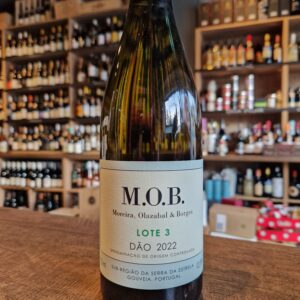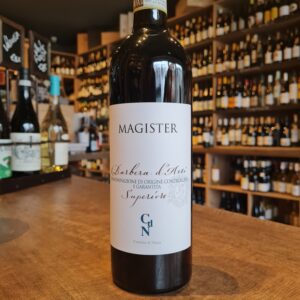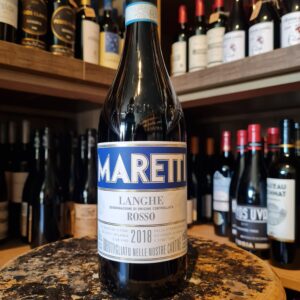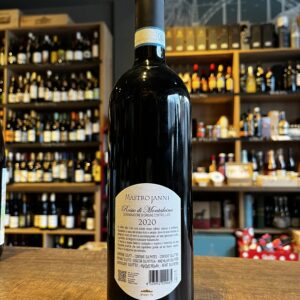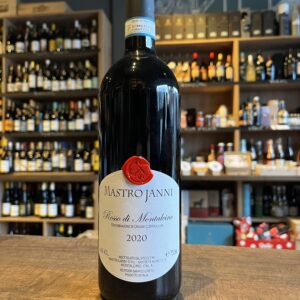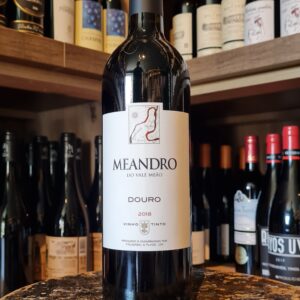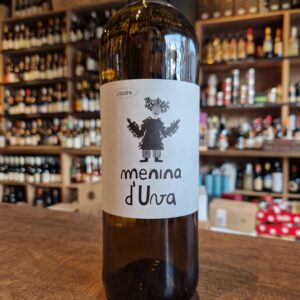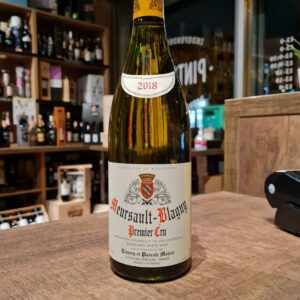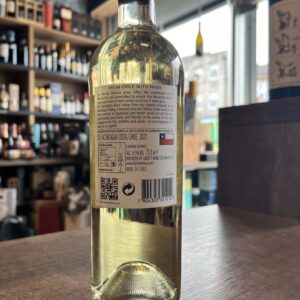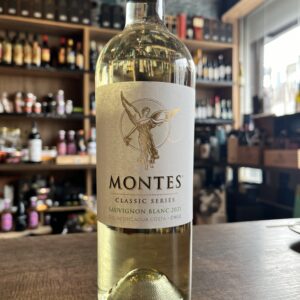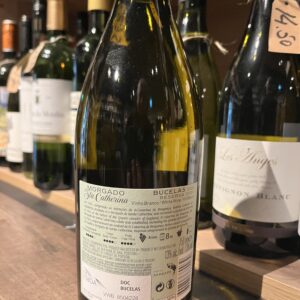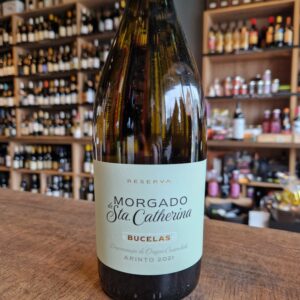-
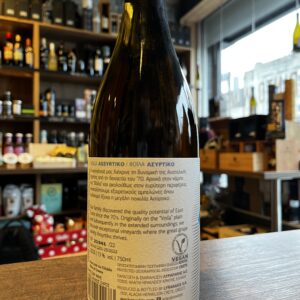
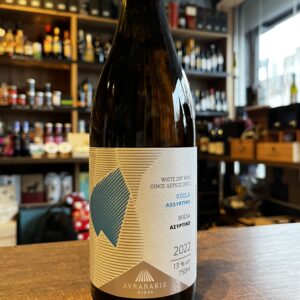 Anyone that has been to Greece or has interest in wines have come by the grape Assyrtiko . In the last few years, wines from Greece, in particularly this indigenous grape, have gotten the status as a world-class wine and prices have begun to rise especially from the Santorini region. This Vegan Assyrtiko from the Lyrarakis estate is one of them and it is still in the affordable range and fortunately, your everyday Assyrtiko needs can still be catered for. Being from east Crete rather than Santorini means prices are still competitive. Think down the lines of getting a wine from the Touraine region rather than the heart of the Loire Valley. Lyrarakis on Crete are a brilliant winery with a focus on indigenous Greek varieties. Their rendition of Assyrtiko is broader and more approachable than some of the tightly-wound examples on Santorini, but it's no less drinkable for that. It is in fact an ideal place to grow the white grape Assyrtiko. Both the Mediterranean breezes and the altitude of the Lyrarakis vineyards allows the grapes to have a much longer ripening period, preserving the grapes aromatics and acidity resulting in a wine with wonderful floral freshness, crisp citrus notes and a delicate mineral finish. Yamas!
Anyone that has been to Greece or has interest in wines have come by the grape Assyrtiko . In the last few years, wines from Greece, in particularly this indigenous grape, have gotten the status as a world-class wine and prices have begun to rise especially from the Santorini region. This Vegan Assyrtiko from the Lyrarakis estate is one of them and it is still in the affordable range and fortunately, your everyday Assyrtiko needs can still be catered for. Being from east Crete rather than Santorini means prices are still competitive. Think down the lines of getting a wine from the Touraine region rather than the heart of the Loire Valley. Lyrarakis on Crete are a brilliant winery with a focus on indigenous Greek varieties. Their rendition of Assyrtiko is broader and more approachable than some of the tightly-wound examples on Santorini, but it's no less drinkable for that. It is in fact an ideal place to grow the white grape Assyrtiko. Both the Mediterranean breezes and the altitude of the Lyrarakis vineyards allows the grapes to have a much longer ripening period, preserving the grapes aromatics and acidity resulting in a wine with wonderful floral freshness, crisp citrus notes and a delicate mineral finish. Yamas! -
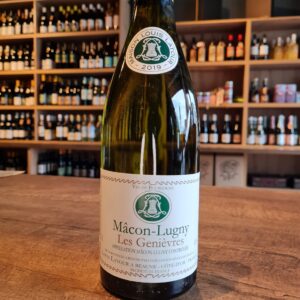 This Macon Lugny Les Genièvres has beautiful aromas of white fruit, muscat, as well as some peppery notes. This is a delicious wine with a round and full mouth(unoaked), it shows distinctive aromas of white fruit, laced with floral notes. Ideal with grilled fish, seafood and Comté cheese. The village of Lugny is located high up in the South of the Mâcon region. It has a great reputation for its white wines which has made Mâcon famous. It is well known that the village of Lugny, with its limestone soils and warm climate, produces the most coveted white wines of the region. The vineyard of « Les Genièvres » is one of the best. Maison Louis Latour selects the best grapes of this village, which thanks to its terroir, was the only village planted with Chardonnay 30 years ago.
This Macon Lugny Les Genièvres has beautiful aromas of white fruit, muscat, as well as some peppery notes. This is a delicious wine with a round and full mouth(unoaked), it shows distinctive aromas of white fruit, laced with floral notes. Ideal with grilled fish, seafood and Comté cheese. The village of Lugny is located high up in the South of the Mâcon region. It has a great reputation for its white wines which has made Mâcon famous. It is well known that the village of Lugny, with its limestone soils and warm climate, produces the most coveted white wines of the region. The vineyard of « Les Genièvres » is one of the best. Maison Louis Latour selects the best grapes of this village, which thanks to its terroir, was the only village planted with Chardonnay 30 years ago. -
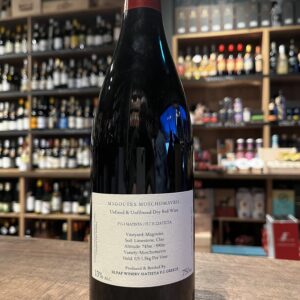
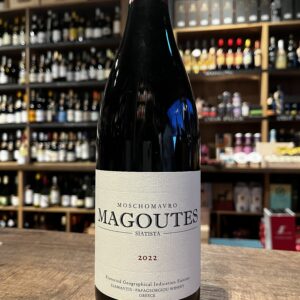 Magoutes winery, run by Dimitris Diamantis, is located in the old but forgotten region of Siatista in the mountains of northern Greece. Here vineyards have been abandoned and then revived centuries ago. The city of Siatista is nestled on the slopes of Mount Siniatsiko. The soils of the vineyards are limestone-based which adds elegance and acidity to this ruby-hued red wine. Moshomavro means 'black muscat' but is no relation in parentage or flavour! Lovers of of Beaujolais or Italian reds like pelaverga, rossesse or schiava will find a lot to appreciate in moschómavro, a variety historically interplanted with xinómavro and others in the western Macedonian mountains. Make sure to open this well in advance to get the full show, as a couple of hours of air will bring out its best qualities. It’s the ideal wine to pair with a cheese and meat board or fish. It’s also lovely with a slight chill on a warm day.
Magoutes winery, run by Dimitris Diamantis, is located in the old but forgotten region of Siatista in the mountains of northern Greece. Here vineyards have been abandoned and then revived centuries ago. The city of Siatista is nestled on the slopes of Mount Siniatsiko. The soils of the vineyards are limestone-based which adds elegance and acidity to this ruby-hued red wine. Moshomavro means 'black muscat' but is no relation in parentage or flavour! Lovers of of Beaujolais or Italian reds like pelaverga, rossesse or schiava will find a lot to appreciate in moschómavro, a variety historically interplanted with xinómavro and others in the western Macedonian mountains. Make sure to open this well in advance to get the full show, as a couple of hours of air will bring out its best qualities. It’s the ideal wine to pair with a cheese and meat board or fish. It’s also lovely with a slight chill on a warm day. -
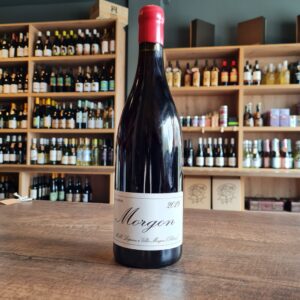 Domaine Marcel Lapierre Morgon is a natural red wine made by Domaine Marcel Lapierre with the Gamay variety in the AOC Morgon (Burgundy). Domaine Marcel Lapierre is one of the pioneer wineries that has been making natural wines since Marcel Lapierre, a true pacesetter among Beaujolais producers, took over the Villié-Morgon estate in 1973. With his work philosophy, he was committed to combining traditional best practices with new technologies so that his wines would be a true reflection of the landscape. In 1981, under the strong influence of natural wine master Jules Chavet, Marcel was among the first to produce wines of minimal intervention, without adding SO2 or any other substance. Domaine Marcel Lapierre Morgon 2018 is a fruity red wine with aromas of cherry, violet and liquorice, covered with a forest freshness and refreshing balsamic tones. On the palate it is structured, fresh and sweet. It begins with a sharp acidity that blends with the touches of fruit and liquorice and the intense minerality. This is a refreshing red, perfect for spring and summer; recommended to drink with charcuterie, paté, cheese, roast ham, roast lamb, roast chicken and turkey and with spicy Thai and Chinese dishes. Serve at the lower end of the suggested temperature range if you like your light red wines served cooler like the French
Domaine Marcel Lapierre Morgon is a natural red wine made by Domaine Marcel Lapierre with the Gamay variety in the AOC Morgon (Burgundy). Domaine Marcel Lapierre is one of the pioneer wineries that has been making natural wines since Marcel Lapierre, a true pacesetter among Beaujolais producers, took over the Villié-Morgon estate in 1973. With his work philosophy, he was committed to combining traditional best practices with new technologies so that his wines would be a true reflection of the landscape. In 1981, under the strong influence of natural wine master Jules Chavet, Marcel was among the first to produce wines of minimal intervention, without adding SO2 or any other substance. Domaine Marcel Lapierre Morgon 2018 is a fruity red wine with aromas of cherry, violet and liquorice, covered with a forest freshness and refreshing balsamic tones. On the palate it is structured, fresh and sweet. It begins with a sharp acidity that blends with the touches of fruit and liquorice and the intense minerality. This is a refreshing red, perfect for spring and summer; recommended to drink with charcuterie, paté, cheese, roast ham, roast lamb, roast chicken and turkey and with spicy Thai and Chinese dishes. Serve at the lower end of the suggested temperature range if you like your light red wines served cooler like the French -
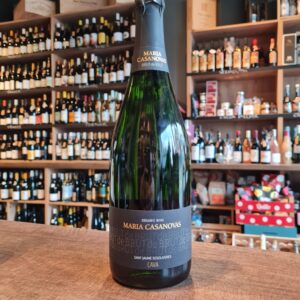 The Bodega or Cava Maria Casanovas is located in the heart of the Penedès, in Sant Sadurní d'Anoia, the centre of Cava production. It is owned by the Casanovas family and managed by three children of Maria Casanovas. Jordi and Jacint are responsible for the vineyards and the cellar, Rosa for administration and marketing. Maria Casanovas' parents were already grape growers and sold their produce to the large cava wineries. Cava has been produced under their own name since 1984. 13 hectares are owned and planted with the local grape varieties Xarel-lo, Parellada and Macabeo (Viura) as well as the international varieties Pinot Noir and Chardonnay. Maria Casanovas was one of the pioneers who introduced Pinot Noir to Penedès. Fossils can be found occasionally in the calcareous, gravelly clay soils. Food pairing suggestion: Apéro pastries, Tagliatelle al tartufo, Vegetable pie, Salad with vegetables, pulses, pasta
The Bodega or Cava Maria Casanovas is located in the heart of the Penedès, in Sant Sadurní d'Anoia, the centre of Cava production. It is owned by the Casanovas family and managed by three children of Maria Casanovas. Jordi and Jacint are responsible for the vineyards and the cellar, Rosa for administration and marketing. Maria Casanovas' parents were already grape growers and sold their produce to the large cava wineries. Cava has been produced under their own name since 1984. 13 hectares are owned and planted with the local grape varieties Xarel-lo, Parellada and Macabeo (Viura) as well as the international varieties Pinot Noir and Chardonnay. Maria Casanovas was one of the pioneers who introduced Pinot Noir to Penedès. Fossils can be found occasionally in the calcareous, gravelly clay soils. Food pairing suggestion: Apéro pastries, Tagliatelle al tartufo, Vegetable pie, Salad with vegetables, pulses, pasta -
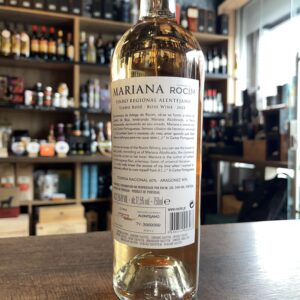
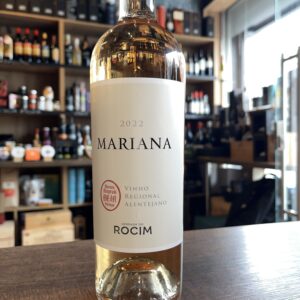 Rocim is the owner of Herdade do Rocim and Vale da Mata. Today, this brand is renowned for the quality of its wine and Cellar. Speaking of its history is speaking of a dream and therefore, it means speaking of the present and future. Because dreams are endless. The “Mariana” Rose is a young and cheerful wine, with generous fruit, freshness and aromatic richness, which reflect the region´s charm. Produced from Touriga Nacional and Aragonez varieties.
Rocim is the owner of Herdade do Rocim and Vale da Mata. Today, this brand is renowned for the quality of its wine and Cellar. Speaking of its history is speaking of a dream and therefore, it means speaking of the present and future. Because dreams are endless. The “Mariana” Rose is a young and cheerful wine, with generous fruit, freshness and aromatic richness, which reflect the region´s charm. Produced from Touriga Nacional and Aragonez varieties. -
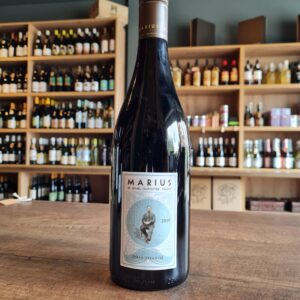 Michel Chapoutier created these wines to honor his great grandfather, Marius Chapoutier. Marius once said, “A good wine is one that beckons us to take another sip” and that is what Michel has accomplished with these wines. Marius Red is a wine that combines power, complexity and elegance. The Syrah endows it with warmth, robustness and a lovely bluish red hue. The Grenache brings a natural sweetness, balancing the whole structure of the wine. The harvest is done during the day: the natural summer heat by the beginning of the autumn is a great benefit for the maturity of the wine. The complexity, the elegance and the gourmet touch of Marius rouge are then revealed by their wine blending know-how. Serve it as an aperitif or with chicken liver on toast, beef carpaccio, roasted vegetables, lamb kebabs, veal, swordfish steak or goat cheese and dark chocolate at the end of the meal. Salut Marius!
Michel Chapoutier created these wines to honor his great grandfather, Marius Chapoutier. Marius once said, “A good wine is one that beckons us to take another sip” and that is what Michel has accomplished with these wines. Marius Red is a wine that combines power, complexity and elegance. The Syrah endows it with warmth, robustness and a lovely bluish red hue. The Grenache brings a natural sweetness, balancing the whole structure of the wine. The harvest is done during the day: the natural summer heat by the beginning of the autumn is a great benefit for the maturity of the wine. The complexity, the elegance and the gourmet touch of Marius rouge are then revealed by their wine blending know-how. Serve it as an aperitif or with chicken liver on toast, beef carpaccio, roasted vegetables, lamb kebabs, veal, swordfish steak or goat cheese and dark chocolate at the end of the meal. Salut Marius! -
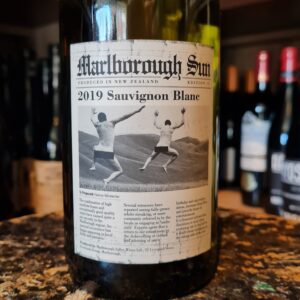 Fantastic New Zealand Sauvignon that will tick all the boxes. The extraordinary label of this wine and the bright recognizable taste have created a direct connection between the Marlborough Sun brand and consumers all over the world. With the growing popularity of Marlborough Valley wines, Saint Clair conceived the idea of creating an affordable, non-pompous wine aimed at attracting new consumers who are not fans of the drink. The progressive technologies of winemaking of the New World, the peculiarities of the terroir of the valley, the varieties that have proven themselves most successfully in the local microclimate and the human factor, have found their reflection in the wines of Marlborough Sun. The inspiration for the labels came from a newspaper article about an unusual phenomenon that has swept the region. It is recommended to serve chilled to a temperature of 8-10 degrees, as a supplement to vegetarian dishes, as well as salmon and tuna.
Fantastic New Zealand Sauvignon that will tick all the boxes. The extraordinary label of this wine and the bright recognizable taste have created a direct connection between the Marlborough Sun brand and consumers all over the world. With the growing popularity of Marlborough Valley wines, Saint Clair conceived the idea of creating an affordable, non-pompous wine aimed at attracting new consumers who are not fans of the drink. The progressive technologies of winemaking of the New World, the peculiarities of the terroir of the valley, the varieties that have proven themselves most successfully in the local microclimate and the human factor, have found their reflection in the wines of Marlborough Sun. The inspiration for the labels came from a newspaper article about an unusual phenomenon that has swept the region. It is recommended to serve chilled to a temperature of 8-10 degrees, as a supplement to vegetarian dishes, as well as salmon and tuna. -
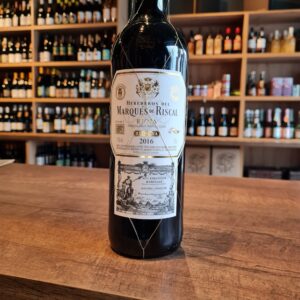 Marqués de Riscal is one of the oldest Rioja wineries. Founded in Elciego (Álava) in 1858 by Guillermo Hurtado de Amézaga. Since the beginning they have always had a clear vocation for creating the quintessential Spanish wines from Rioja. Marqués de Riscal Reserva is a red wine made with Tempranillo, Graciano and Mazuelo from vineyards that are over 40 years old, located on clayey-calcareous soils. After the harvest, the grapes ferment at a controlled temperature with a maceration of 12 days. Once the harvest has finished, the wine goes through a minimum ageing of 2 years in American oak barrels. It is left to stand in the bottle for a minimum of one year before it is launched on to the market. A wine that falls within the canons of Riojan classicism, fresh, fine, elegant and with great ageing potential.
Marqués de Riscal is one of the oldest Rioja wineries. Founded in Elciego (Álava) in 1858 by Guillermo Hurtado de Amézaga. Since the beginning they have always had a clear vocation for creating the quintessential Spanish wines from Rioja. Marqués de Riscal Reserva is a red wine made with Tempranillo, Graciano and Mazuelo from vineyards that are over 40 years old, located on clayey-calcareous soils. After the harvest, the grapes ferment at a controlled temperature with a maceration of 12 days. Once the harvest has finished, the wine goes through a minimum ageing of 2 years in American oak barrels. It is left to stand in the bottle for a minimum of one year before it is launched on to the market. A wine that falls within the canons of Riojan classicism, fresh, fine, elegant and with great ageing potential. -
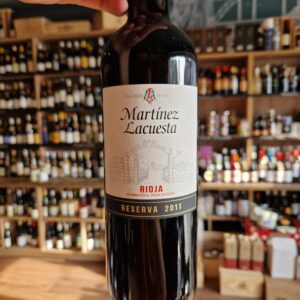 Bodegas Martínez Lacuesta was founded in 1895 in Haro by Félix Martínez Lacuesta. A winemaker, lawyer, politician and publicist, he was the first president of the National Association of Winegrowers and Wine Industries, as well as of the Rioja Wine Union. He was also one of the creators of the Regulating Board of D.O. Rioja, where he represented his fellow winemakers. The philosophy of this century-old winery is to produce the best wines from the best grapes. To do so, they have plots distributed throughout Rioja Alta, searching for the best vineyards and buying, up until this day, new plots to plant new vines. Martínez Lacuesta Reserva is a wine made from Tempranillo, Graciano and Mazuelo, from vineyards located at 450-600 metres of altitude. Their vines, of an average of 25 years old, are planted on clayey-calcareous soils. Suitable to accompany white or red meats, fishes with sauce, grilled meat or vegetables
Bodegas Martínez Lacuesta was founded in 1895 in Haro by Félix Martínez Lacuesta. A winemaker, lawyer, politician and publicist, he was the first president of the National Association of Winegrowers and Wine Industries, as well as of the Rioja Wine Union. He was also one of the creators of the Regulating Board of D.O. Rioja, where he represented his fellow winemakers. The philosophy of this century-old winery is to produce the best wines from the best grapes. To do so, they have plots distributed throughout Rioja Alta, searching for the best vineyards and buying, up until this day, new plots to plant new vines. Martínez Lacuesta Reserva is a wine made from Tempranillo, Graciano and Mazuelo, from vineyards located at 450-600 metres of altitude. Their vines, of an average of 25 years old, are planted on clayey-calcareous soils. Suitable to accompany white or red meats, fishes with sauce, grilled meat or vegetables -
Out of stock
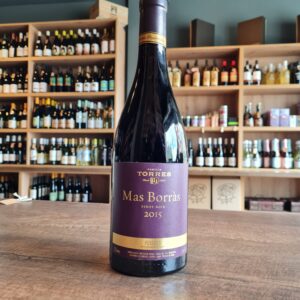 Torres Mas Borras Pinot Noir is a single vineyard wine made from 100% Pinot Noir vines in the Penedès denominación de origen of the Spanish region of Catalonia. The Torres family has been making wine in the ancient Catalán town of Vilafranca del Penedès, south-west of Barcelona, since the 17th Century. It is this tradition combined with innovation, dynamism and commitment to quality that has put Torres firmly on the world map. They remain one of the largest family owned and run wine companies in the world and, under the stewardship of fourth generation Miguel Torres they are committed to sustainable viticulture and green practices. The Torres Mas Borras vineyard is located at 520 metres above sea level in the coolest part of the Upper Penedes area at Santa María de Miralles. At this altitude, the relatively cold summer nights allow a long and balanced ripening, which is desirable for producing elegant and noble Pinot Noir. Deep calcareous clay soils with interspersed layers of gypsum, moderately well drained with a high water holding capacity. Developed over sedimentary material from the Eocene. Thanks to the cool soils and the continental tendency of the climate, these vineyards provide the best conditions for Pinot Noir in the Penedès region. This is why Jacques Bergeret, a Burgundian expert in cultivating Pinot Noir, chose these soils in 1985–1986. The Pinot Noir grapes for this single vineyard wine are usually harvested in late September and are macerated in the skins for 2 weeks after harvest. The wine is fermented in stainless steel with an additional malolactic fermentation in oak barrels. After vinification Torres Mas Borras Pinot Noir is aged in French oak barrels, 30% of which are new, for 9 months. Oak ageing ensure that silky tannins are in harmony with the fresh acidity and cherry fruit typical of Pinot Noir.
Torres Mas Borras Pinot Noir is a single vineyard wine made from 100% Pinot Noir vines in the Penedès denominación de origen of the Spanish region of Catalonia. The Torres family has been making wine in the ancient Catalán town of Vilafranca del Penedès, south-west of Barcelona, since the 17th Century. It is this tradition combined with innovation, dynamism and commitment to quality that has put Torres firmly on the world map. They remain one of the largest family owned and run wine companies in the world and, under the stewardship of fourth generation Miguel Torres they are committed to sustainable viticulture and green practices. The Torres Mas Borras vineyard is located at 520 metres above sea level in the coolest part of the Upper Penedes area at Santa María de Miralles. At this altitude, the relatively cold summer nights allow a long and balanced ripening, which is desirable for producing elegant and noble Pinot Noir. Deep calcareous clay soils with interspersed layers of gypsum, moderately well drained with a high water holding capacity. Developed over sedimentary material from the Eocene. Thanks to the cool soils and the continental tendency of the climate, these vineyards provide the best conditions for Pinot Noir in the Penedès region. This is why Jacques Bergeret, a Burgundian expert in cultivating Pinot Noir, chose these soils in 1985–1986. The Pinot Noir grapes for this single vineyard wine are usually harvested in late September and are macerated in the skins for 2 weeks after harvest. The wine is fermented in stainless steel with an additional malolactic fermentation in oak barrels. After vinification Torres Mas Borras Pinot Noir is aged in French oak barrels, 30% of which are new, for 9 months. Oak ageing ensure that silky tannins are in harmony with the fresh acidity and cherry fruit typical of Pinot Noir. -
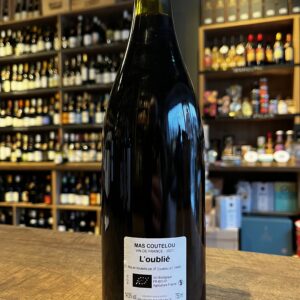
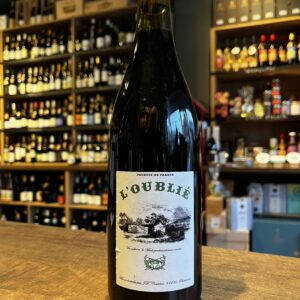 The varieties Jeff grows are all from the south of France, and on his estate located in Puimuisson (a few kilometers from Beziers), the vines coexist with thousands of fruit trees to promote biodiversity. From this base, each vintage offers a range of unique cuvées. Wines he invents at any time following his intuition and that only go onto the market when he considers them representative of the character of the place. Specifically, Mas Coutelou L'Oublié Version is a wine made from Syrah, Carignan and Cinsault vines.
The varieties Jeff grows are all from the south of France, and on his estate located in Puimuisson (a few kilometers from Beziers), the vines coexist with thousands of fruit trees to promote biodiversity. From this base, each vintage offers a range of unique cuvées. Wines he invents at any time following his intuition and that only go onto the market when he considers them representative of the character of the place. Specifically, Mas Coutelou L'Oublié Version is a wine made from Syrah, Carignan and Cinsault vines. -
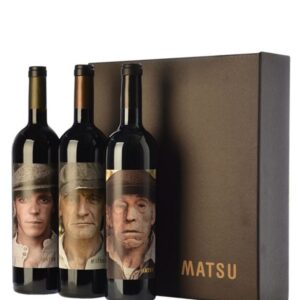 Matsu, the Japanese word for 'wait', pays homage to the generations of devoted wine makers. The images of the real-life wine-producers decorate the bottle and represent the essence of each of the wines. Picaro means 'rogue' or 'rascal', and this rapscallion of a wine is a youthful interpretation of the Toro region's style. El Recio translates as 'the tough guy', and is a more serious, mature wine, made from the product of some of Toro's oldest vines. 'The Old One' of the Matsu range, made from the fruit of selected Tinta de Toro vines, averaging 110 years of age - presented in an original gift box.
Matsu, the Japanese word for 'wait', pays homage to the generations of devoted wine makers. The images of the real-life wine-producers decorate the bottle and represent the essence of each of the wines. Picaro means 'rogue' or 'rascal', and this rapscallion of a wine is a youthful interpretation of the Toro region's style. El Recio translates as 'the tough guy', and is a more serious, mature wine, made from the product of some of Toro's oldest vines. 'The Old One' of the Matsu range, made from the fruit of selected Tinta de Toro vines, averaging 110 years of age - presented in an original gift box. -
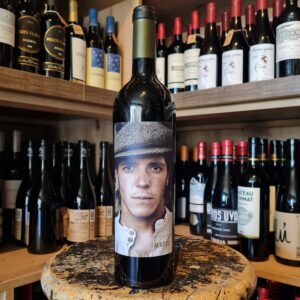 Picaro means 'rogue' or 'rascal'. I have always called it the young lad, as they also have 'El Recio' (the middle aged man) which is Matsu's idea for a reserva wine and the Gran Reserva, 'El Viejo' (old man just in case you didn't know). Bodegas Matsu is situated in the Toro region, right beside the Rueda region (known for the famous Verdejos). Toro wines are predominantly made of Tinta de Toro (tempranillo in this area of Spain) and are well known to be a mouthful of strength and personality due to its poor soil and hot summers. These vines in particular are 90 years old and are cultivated using the biodynamic techniques. Although the more conventional wines of this region are quite sharp, Matsu's wine range has achieved smoothness and elegance. Additionally, the clever thinking behind the labels means that they cater to a wide audience. I would recommend this red any day of the week.
Picaro means 'rogue' or 'rascal'. I have always called it the young lad, as they also have 'El Recio' (the middle aged man) which is Matsu's idea for a reserva wine and the Gran Reserva, 'El Viejo' (old man just in case you didn't know). Bodegas Matsu is situated in the Toro region, right beside the Rueda region (known for the famous Verdejos). Toro wines are predominantly made of Tinta de Toro (tempranillo in this area of Spain) and are well known to be a mouthful of strength and personality due to its poor soil and hot summers. These vines in particular are 90 years old and are cultivated using the biodynamic techniques. Although the more conventional wines of this region are quite sharp, Matsu's wine range has achieved smoothness and elegance. Additionally, the clever thinking behind the labels means that they cater to a wide audience. I would recommend this red any day of the week. -
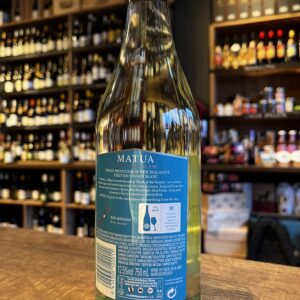
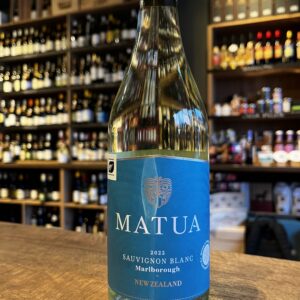 This wine represents the legend of Kupe tangling with a giant octopus who kept stealing all his fish off the hook. During the ensuing fight the beast's tentacles gouged out the Marlborough Sounds and Kupe cut out its eyes which he placed on two rocks known today as Nga Whatu ' The Eyes'. It’s hard to separate New Zealand and Sauvignon Blanc these days, but Matua were the first to put them together, over 40 years ago. You could say They've changed the way the world enjoys white wine. As the Head of the Family (the Maori translation of Matua) They have a tradition of telling stories as a way of passing on knowledge to the next generation. Their most famous winegrowing regions set the scene for some great legendary historical folklore. Wines match dishes from cooked salmon, lettuce, chicken and mushrooms.
This wine represents the legend of Kupe tangling with a giant octopus who kept stealing all his fish off the hook. During the ensuing fight the beast's tentacles gouged out the Marlborough Sounds and Kupe cut out its eyes which he placed on two rocks known today as Nga Whatu ' The Eyes'. It’s hard to separate New Zealand and Sauvignon Blanc these days, but Matua were the first to put them together, over 40 years ago. You could say They've changed the way the world enjoys white wine. As the Head of the Family (the Maori translation of Matua) They have a tradition of telling stories as a way of passing on knowledge to the next generation. Their most famous winegrowing regions set the scene for some great legendary historical folklore. Wines match dishes from cooked salmon, lettuce, chicken and mushrooms. -
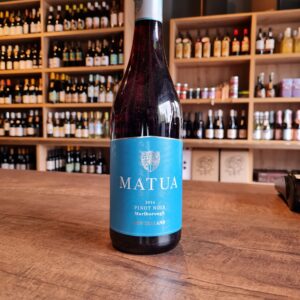 The name Matua, in New Zealand's native Maori language, means "head of the family," an appropriate title given this winery's instrumental role in developing Sauvignon Blanc into what is now New Zealand's most acknowledged wine varietal. You see there’s a couple of regions around the globe that planted Pinot Noir, that have really mastered it and New Zealands' Marlborough is indisputably one of those. It’s funny what a little perseverance does, and from their ragged tin shed in 1974, Bill and Ross Spence began to change the very foundation of wine in not just Marlborough, but New Zealand. They realized that Pinot Noir adapted exceptionally well to the well-drained alluvial soils of Marlborough and it’s unique climate. With the perfect amount of sunshine each day balanced out by cool evenings they struck Pinot Noir gold and have been developing a killer selection ever since. Matua have mastered the perfect balance of fruit-forward freshness with a touch of dry spice, a staple trait of the Marlborough Pinot Noir. You can expect generous aromas of freshly picked strawberries and red with a little ripe plum thrown into the mix. When taking a sip it’s the soft redcurrants, strawberries and cherries that jump out, brought together by a subtle spice, light tobacco and soothing dry earth. A touch of oak gives just enough complexity to enhance the flavors of this incredible wine. Highly Recommended
The name Matua, in New Zealand's native Maori language, means "head of the family," an appropriate title given this winery's instrumental role in developing Sauvignon Blanc into what is now New Zealand's most acknowledged wine varietal. You see there’s a couple of regions around the globe that planted Pinot Noir, that have really mastered it and New Zealands' Marlborough is indisputably one of those. It’s funny what a little perseverance does, and from their ragged tin shed in 1974, Bill and Ross Spence began to change the very foundation of wine in not just Marlborough, but New Zealand. They realized that Pinot Noir adapted exceptionally well to the well-drained alluvial soils of Marlborough and it’s unique climate. With the perfect amount of sunshine each day balanced out by cool evenings they struck Pinot Noir gold and have been developing a killer selection ever since. Matua have mastered the perfect balance of fruit-forward freshness with a touch of dry spice, a staple trait of the Marlborough Pinot Noir. You can expect generous aromas of freshly picked strawberries and red with a little ripe plum thrown into the mix. When taking a sip it’s the soft redcurrants, strawberries and cherries that jump out, brought together by a subtle spice, light tobacco and soothing dry earth. A touch of oak gives just enough complexity to enhance the flavors of this incredible wine. Highly Recommended -
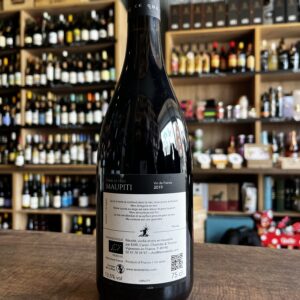
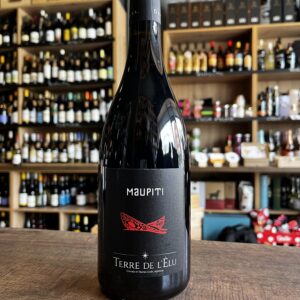 In January 2008, Charlotte and Thomas embarked on a marvelous winemaking adventure with the acquisition of the Clos de l’Élu domain, on the schist-rich lands of the Anjou Noir. With many years’ experience as a wine consultant (Thomas), in the fields of communication and management (Charlotte), they are both deeply passionate about the life of this domain which lies on the finest terroirs of the Layon valley. The 20 hectares are farmed organically and the domain offers a structured range of different wines. If it was the Chenin that attracted Thomas to Anjou, the red grape varieties (Cabernet Franc, Grolleau, Pineau d’Aunis, gamay) continue to inspire him with deep, rich vintages that are expressive and full of finesse. The team is driven by strong convictions, from the work in the vineyard to the cellar, in order to produce wines that truly reflect the terroir. In the vineyards: the whole domain was converted to organic farming in April 2010 (first certified organic vintage in 2013), severe disbudding, appropriate pruning modes depending on the grape variety and plot, soil work, manual harvest in 20 kg boxes, draconian sorting while harvesting. In the cellar: use of gravity as much as possible, natural fermentations, winemaking choice favoring the least manipulation of the grapes possible, winemaking of the reds in whole bunches, maceration and aging in tanks, weathered (or aged) barrels or clay amphorae.
In January 2008, Charlotte and Thomas embarked on a marvelous winemaking adventure with the acquisition of the Clos de l’Élu domain, on the schist-rich lands of the Anjou Noir. With many years’ experience as a wine consultant (Thomas), in the fields of communication and management (Charlotte), they are both deeply passionate about the life of this domain which lies on the finest terroirs of the Layon valley. The 20 hectares are farmed organically and the domain offers a structured range of different wines. If it was the Chenin that attracted Thomas to Anjou, the red grape varieties (Cabernet Franc, Grolleau, Pineau d’Aunis, gamay) continue to inspire him with deep, rich vintages that are expressive and full of finesse. The team is driven by strong convictions, from the work in the vineyard to the cellar, in order to produce wines that truly reflect the terroir. In the vineyards: the whole domain was converted to organic farming in April 2010 (first certified organic vintage in 2013), severe disbudding, appropriate pruning modes depending on the grape variety and plot, soil work, manual harvest in 20 kg boxes, draconian sorting while harvesting. In the cellar: use of gravity as much as possible, natural fermentations, winemaking choice favoring the least manipulation of the grapes possible, winemaking of the reds in whole bunches, maceration and aging in tanks, weathered (or aged) barrels or clay amphorae.Technical Sheet
-
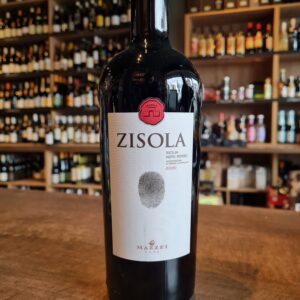 Mazzei is the name of one of the most famous and richest families in the history of Tuscan winemaking, the truth is that their desire to discover and experience other things led them to look for other areas where they could continue their winemaking adventure. So, in 2003, they became aware of the great potential hidden within the Val di Noto region in southeastern Sicily (Italy). A total of 21 hectares of vineyards where Tuscan passion meets Sicilian tradition. Zisola is made only from traditional "Alberello" (bushy) vines grown near Noto, an unique area to make wine. The proximity of the sea and the soil rich in limestone allow to best balance the natural Nero d'Avola exuberance, with a great freshness and elegance. Spicy fish soups, savoury pasta and rice dishes, grilled red meats and vegetables.
Mazzei is the name of one of the most famous and richest families in the history of Tuscan winemaking, the truth is that their desire to discover and experience other things led them to look for other areas where they could continue their winemaking adventure. So, in 2003, they became aware of the great potential hidden within the Val di Noto region in southeastern Sicily (Italy). A total of 21 hectares of vineyards where Tuscan passion meets Sicilian tradition. Zisola is made only from traditional "Alberello" (bushy) vines grown near Noto, an unique area to make wine. The proximity of the sea and the soil rich in limestone allow to best balance the natural Nero d'Avola exuberance, with a great freshness and elegance. Spicy fish soups, savoury pasta and rice dishes, grilled red meats and vegetables. -
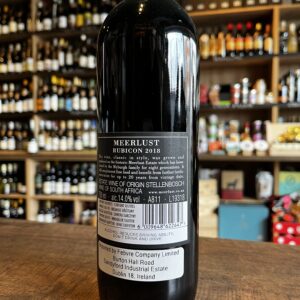
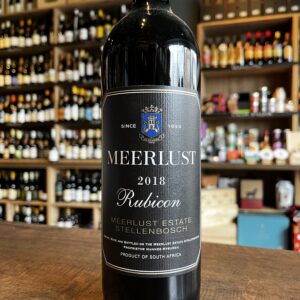 Meerlust Rubicon had a great impact on the history of South African wine. First made in 1980, it essentially set the pattern for Bordeaux blends in the country. There was of course a few pioners at this front that only used Cabernet Sauvignon varietal such as Kanonkop (Paul Sauer) in 1973 but as a blend as per Bordeaux style Meerlust changed the scene. According to Hannes Myburgh, his father was inspired by Julious Cesar words “Alea iacta est. The die is cast,” leading his troops towards Rome in 49BC. As this was a irreversable moment in history as there was no turning back after crossing the Rubicon river as this profoundly shifted Roman politics. Nico Myburgh from the 7th generation of the Meerlust estate and father of the current custodian, was holidaying in Bordeaux when he discovered that the terroir in this area of France was similar to that of the Eerste River Valley. Both have a distinctive climate, characterised by a cooling sea breeze. And both have a soil structure made up of decomposed granite and clay. The red wines produced by the two regions, however, were very different. Unlike the Western Cape’s specified cultivars, Bordeaux thrived on producing blends. Nico returned to Meerlust, filled with inspiration and the desire to create a blend of his own that would match those of the French. In 1980, after several years of experimentation together with winemaker Giorgio Dalla Cia, he announced the birth of the new blend. With proportions of 70% Cabernet Sauvignon, 20% Merlot and 10% Cabernet Franc, a new style of wine had been created in South Africa. Like Caesar, there could be no turning back. Nico and Giorgio had already considered a number of names for the new blend when Professor Dirk Opperman from the University of Stellenbosch, a friend of Nico’s suggested that “Rubicon” might be appropriate. The pair had, after all, crossed a new frontier – and changed the way South Africans thought about red wine. The Cabernet Sauvignon, Merlot, Cabernet Franc and Petit Verdot vineyards are hand harvested from February through to March and each individual vineyard block is kept separate throughout the fermentation process and monitored until the moment of blending.In wintertime, after malolactic fermentation has allowed the personality of each vineyard to assert itself in barrel, the wines are carefully assessed to produce the most expressive, harmonious and complex wine. The blend is assembled and then allowed another year in barrel for the components to harmonise. The wine is finally bottled and left for a further 2 years before release. Rubicon is always released at four years of age and will immediately offer the distinctive character and quality of the Estate. However, further bottle maturation is advised for the intriguing complexity of this classic wine to unfold and reveal itself.The first vintage, the 1980, remains vivacious and very much alive, even 30+ years after vintage. Subsequent vintages all express the personality and characteristics of their specific year. All vintages of Rubicon, however, share the hallmarks of wines grown at this special place: intensity, harmony, vibrancy, complexity and individuality.I suppose we could use here ''Veni, vidi, vici''
Meerlust Rubicon had a great impact on the history of South African wine. First made in 1980, it essentially set the pattern for Bordeaux blends in the country. There was of course a few pioners at this front that only used Cabernet Sauvignon varietal such as Kanonkop (Paul Sauer) in 1973 but as a blend as per Bordeaux style Meerlust changed the scene. According to Hannes Myburgh, his father was inspired by Julious Cesar words “Alea iacta est. The die is cast,” leading his troops towards Rome in 49BC. As this was a irreversable moment in history as there was no turning back after crossing the Rubicon river as this profoundly shifted Roman politics. Nico Myburgh from the 7th generation of the Meerlust estate and father of the current custodian, was holidaying in Bordeaux when he discovered that the terroir in this area of France was similar to that of the Eerste River Valley. Both have a distinctive climate, characterised by a cooling sea breeze. And both have a soil structure made up of decomposed granite and clay. The red wines produced by the two regions, however, were very different. Unlike the Western Cape’s specified cultivars, Bordeaux thrived on producing blends. Nico returned to Meerlust, filled with inspiration and the desire to create a blend of his own that would match those of the French. In 1980, after several years of experimentation together with winemaker Giorgio Dalla Cia, he announced the birth of the new blend. With proportions of 70% Cabernet Sauvignon, 20% Merlot and 10% Cabernet Franc, a new style of wine had been created in South Africa. Like Caesar, there could be no turning back. Nico and Giorgio had already considered a number of names for the new blend when Professor Dirk Opperman from the University of Stellenbosch, a friend of Nico’s suggested that “Rubicon” might be appropriate. The pair had, after all, crossed a new frontier – and changed the way South Africans thought about red wine. The Cabernet Sauvignon, Merlot, Cabernet Franc and Petit Verdot vineyards are hand harvested from February through to March and each individual vineyard block is kept separate throughout the fermentation process and monitored until the moment of blending.In wintertime, after malolactic fermentation has allowed the personality of each vineyard to assert itself in barrel, the wines are carefully assessed to produce the most expressive, harmonious and complex wine. The blend is assembled and then allowed another year in barrel for the components to harmonise. The wine is finally bottled and left for a further 2 years before release. Rubicon is always released at four years of age and will immediately offer the distinctive character and quality of the Estate. However, further bottle maturation is advised for the intriguing complexity of this classic wine to unfold and reveal itself.The first vintage, the 1980, remains vivacious and very much alive, even 30+ years after vintage. Subsequent vintages all express the personality and characteristics of their specific year. All vintages of Rubicon, however, share the hallmarks of wines grown at this special place: intensity, harmony, vibrancy, complexity and individuality.I suppose we could use here ''Veni, vidi, vici'' -
 Menina d’Uva is a small winery located in Uva, a remote village in the quiet and desolate countryside of the Northeast of Portugal. Female winemaker Aline Domingues moved from Paris to this area from which her parents had emigrated to Paris to give their children better opportunities. A controversial move within the family but one that I wholeheartedly support. Aline clearly is a talented winemaker crafting beautifully pure wines. Made from 70% red grapes (including Bastardo, known in the Jura as Trousseau) and 30% white grapes including Malvasia and white Bastardo. It’s still a hearthy red that’s crispy and refreshing; cherries, pomegranate with a beautiful smell of the forest. Highly recommended.
Menina d’Uva is a small winery located in Uva, a remote village in the quiet and desolate countryside of the Northeast of Portugal. Female winemaker Aline Domingues moved from Paris to this area from which her parents had emigrated to Paris to give their children better opportunities. A controversial move within the family but one that I wholeheartedly support. Aline clearly is a talented winemaker crafting beautifully pure wines. Made from 70% red grapes (including Bastardo, known in the Jura as Trousseau) and 30% white grapes including Malvasia and white Bastardo. It’s still a hearthy red that’s crispy and refreshing; cherries, pomegranate with a beautiful smell of the forest. Highly recommended. -
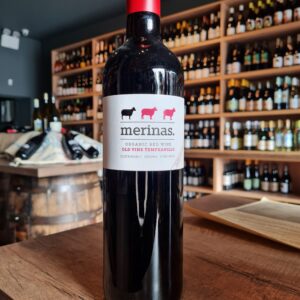 The Mesta was a powerful alliance of shepherds in medieval Castile, who controlled the “cañadas”: traditional rights-of-way for migrating sheep. to this day, the “cañadas” are protected from being blocked or built upon. Our vineyards are nestled deep in the land of The Mesta, and are still passed over by flocks on their annual migration – a reminder of ancient rights, and a cultural cue for continued co-existence with nature. Produced from organically farmed vineyards in Uclés (Castile, Spain). Managed as an integrated ecosystem and studded with centenary oak trees. The continental climate with sunny days and cool nights allow us to achieve intense fruit and excellent varietal definition, while retaining remarkable freshness Mesta Tempranillo is a vibrant and juicy, unoaked red wine, showing great purity and the typicity of high-altitude Tempranillo, with expressive and well-defined aromas of red berries, rosemary and a touch of liquorice. Bright ruby red colour. Fresh and with an excellent persistence on the palate, with round texture and a satisfyingly dry finish. Very versatile, medium-bodied food wine, excellent with tapas, grilled meat and pasta.
The Mesta was a powerful alliance of shepherds in medieval Castile, who controlled the “cañadas”: traditional rights-of-way for migrating sheep. to this day, the “cañadas” are protected from being blocked or built upon. Our vineyards are nestled deep in the land of The Mesta, and are still passed over by flocks on their annual migration – a reminder of ancient rights, and a cultural cue for continued co-existence with nature. Produced from organically farmed vineyards in Uclés (Castile, Spain). Managed as an integrated ecosystem and studded with centenary oak trees. The continental climate with sunny days and cool nights allow us to achieve intense fruit and excellent varietal definition, while retaining remarkable freshness Mesta Tempranillo is a vibrant and juicy, unoaked red wine, showing great purity and the typicity of high-altitude Tempranillo, with expressive and well-defined aromas of red berries, rosemary and a touch of liquorice. Bright ruby red colour. Fresh and with an excellent persistence on the palate, with round texture and a satisfyingly dry finish. Very versatile, medium-bodied food wine, excellent with tapas, grilled meat and pasta. -
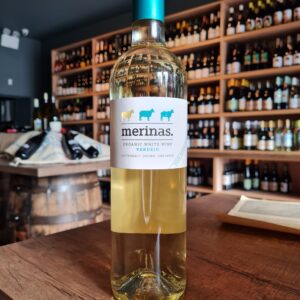 Merinas comes from the Bodegas y Viñedos Fontana, located in the town of Cuenca. The name Merinas is also a reference to the merino sheep, the most famous sheep breed in the world which, incidentally, sometimes seems to scurry around in the vines. A crisp, aromatic white wine, showing great purity of aromas and a precise expression of the Verdejo grape. Bright, pale straw yellow, with intense, fresh notes of grass, fennel and white pepper. Dry but juicy on the palate, with excellent balance, a moderate alcohol of only 12,5% with a persistent, slightly mineral finish. Excellent as an aperitif and with pasta, salads, poultry and fish dishes.
Merinas comes from the Bodegas y Viñedos Fontana, located in the town of Cuenca. The name Merinas is also a reference to the merino sheep, the most famous sheep breed in the world which, incidentally, sometimes seems to scurry around in the vines. A crisp, aromatic white wine, showing great purity of aromas and a precise expression of the Verdejo grape. Bright, pale straw yellow, with intense, fresh notes of grass, fennel and white pepper. Dry but juicy on the palate, with excellent balance, a moderate alcohol of only 12,5% with a persistent, slightly mineral finish. Excellent as an aperitif and with pasta, salads, poultry and fish dishes. -
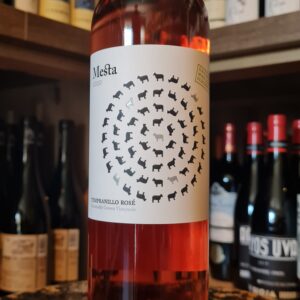 Mesta is a range of organically and sustainably grown single varietal wines, which stylishly showcase the Spanish wine revolution under the symbol of the Mesta. Mesta was a powerful alliance of sheep ranchers in medieval Castile, who controlled the cañadas: the traditional rights of way for migrating sheep. To this day the cañadas are protected from being blocked or built upon, a reminder of ancient rights and a model of coexistence with nature. This modern range, from the fashionable DO Uclés in central Castile, offers wines of great purity and varietal typicity.A versatile wine which accompanies spicy dishes perfectly, Asian curries, seafood risotto or a light salad with grilled prawns. Rosé wines are in fashion not just in the summer but also throughout the year, and this beautiful Mesta Rosé is a serious contender in the Rosé world. Especially at this price!!!
Mesta is a range of organically and sustainably grown single varietal wines, which stylishly showcase the Spanish wine revolution under the symbol of the Mesta. Mesta was a powerful alliance of sheep ranchers in medieval Castile, who controlled the cañadas: the traditional rights of way for migrating sheep. To this day the cañadas are protected from being blocked or built upon, a reminder of ancient rights and a model of coexistence with nature. This modern range, from the fashionable DO Uclés in central Castile, offers wines of great purity and varietal typicity.A versatile wine which accompanies spicy dishes perfectly, Asian curries, seafood risotto or a light salad with grilled prawns. Rosé wines are in fashion not just in the summer but also throughout the year, and this beautiful Mesta Rosé is a serious contender in the Rosé world. Especially at this price!!! -
Out of stock
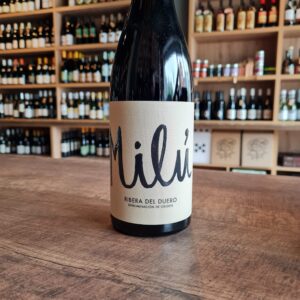 A rich and satisfying Ribera del Duero red, from a quality focussed micro producer Quinta Milú. This is a family run project in the Ribera del Duero from the Asturian viticulturist Germán R. Blanco. A small project which for nearly 10 years now has looked for wines which tell us about where they were born, a small village by the name of La Aguilera situated in the province of Burgos. Germán makes his elegant, fruit-forward wines using foot-treading, wild yeast fermentation and minimal handling. Not filtered, not clarified and not stabilized is his ethos. All his wines share a delicious rusticity, purity of fruit, and incredible freshness. Germán calls this— his flagship wine— a “vino de pueblo”, which translates as “a wine for every day and for everyone.” Pair it with braised meats, steak, game, lamb, root veggies, hard cheese or just have it on its own.
A rich and satisfying Ribera del Duero red, from a quality focussed micro producer Quinta Milú. This is a family run project in the Ribera del Duero from the Asturian viticulturist Germán R. Blanco. A small project which for nearly 10 years now has looked for wines which tell us about where they were born, a small village by the name of La Aguilera situated in the province of Burgos. Germán makes his elegant, fruit-forward wines using foot-treading, wild yeast fermentation and minimal handling. Not filtered, not clarified and not stabilized is his ethos. All his wines share a delicious rusticity, purity of fruit, and incredible freshness. Germán calls this— his flagship wine— a “vino de pueblo”, which translates as “a wine for every day and for everyone.” Pair it with braised meats, steak, game, lamb, root veggies, hard cheese or just have it on its own. -
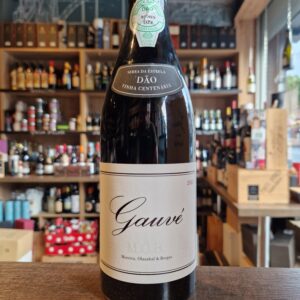 This project was born from the will of three winemakers, Jorge Moreira, Francisco Olazabal and Jorge Serôdio Borges, to make a wine together. The chosen region was the Dão, a region for which there is a common admiration that was born in the tasting of older wines, from the 60s and 70s that surprise for their elegance and freshness. The identity and complexity of these wines is indeed remarkable and serves as an inspiration for MOB wines.
This project was born from the will of three winemakers, Jorge Moreira, Francisco Olazabal and Jorge Serôdio Borges, to make a wine together. The chosen region was the Dão, a region for which there is a common admiration that was born in the tasting of older wines, from the 60s and 70s that surprise for their elegance and freshness. The identity and complexity of these wines is indeed remarkable and serves as an inspiration for MOB wines. -
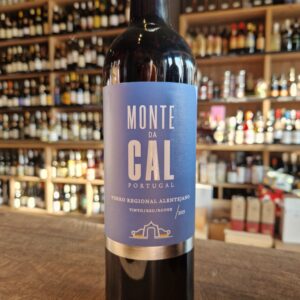 It is in the heart of the genuine Alentejo, with its unique aromas, flavors and textures, nature, silence and immensity, that the 80 hectares of vineyards at Herdade Monte da Cal, located in the municipality of Fronteira, in the parish of São Saturnino, extend over 80 hectares of vineyards. about 40 km from Portalegre. Surrounded by the tranquility of the northern Alentejo plain, it is part of the calm environment of nature characteristic of this part of the country, surrounded by an infinity of vineyards, which we can only see, far away. Here, the red varieties Trincadeira, Syrah, Aragonês, Alicante Bouschet, Alfrocheiro and Touriga Nacional are planted. The architecture and decoration of the estate reflect the Arab influences, so present in the Alentejo culture. The estate’s modern winery is a fundamental pillar to reinforce the visibility of the wines of this house, and a wine tourism project is already planned for this property. Suggested pairing with dishes from the Mediterranean, Chinese, Indian and African cuisine.
It is in the heart of the genuine Alentejo, with its unique aromas, flavors and textures, nature, silence and immensity, that the 80 hectares of vineyards at Herdade Monte da Cal, located in the municipality of Fronteira, in the parish of São Saturnino, extend over 80 hectares of vineyards. about 40 km from Portalegre. Surrounded by the tranquility of the northern Alentejo plain, it is part of the calm environment of nature characteristic of this part of the country, surrounded by an infinity of vineyards, which we can only see, far away. Here, the red varieties Trincadeira, Syrah, Aragonês, Alicante Bouschet, Alfrocheiro and Touriga Nacional are planted. The architecture and decoration of the estate reflect the Arab influences, so present in the Alentejo culture. The estate’s modern winery is a fundamental pillar to reinforce the visibility of the wines of this house, and a wine tourism project is already planned for this property. Suggested pairing with dishes from the Mediterranean, Chinese, Indian and African cuisine. -
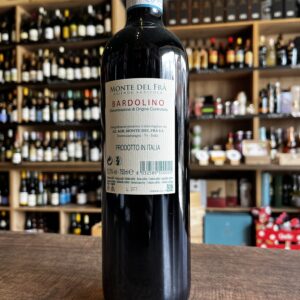
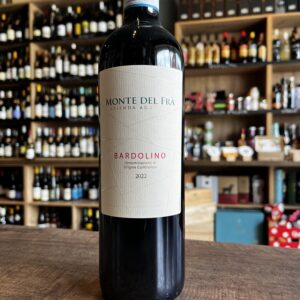 This wine is from the hills that are located in a Guyot at 100/150 meters above sea level, of morainic origin with calcareous, clayey, gravelly, sandy soil.From the municipality of Sommacampagna located southeast of Lake Garda.A well-balanced, fresh and easy-drinking style dry and rounded red wine. Delicately fruity and fragrant, with notes of cherries, strawberries, raspberries and red currants as well as hints of spices. Recommended with light snacks, cold cuts, light meals, tapas, pasta and fish in general (particularly freshwater fish).
This wine is from the hills that are located in a Guyot at 100/150 meters above sea level, of morainic origin with calcareous, clayey, gravelly, sandy soil.From the municipality of Sommacampagna located southeast of Lake Garda.A well-balanced, fresh and easy-drinking style dry and rounded red wine. Delicately fruity and fragrant, with notes of cherries, strawberries, raspberries and red currants as well as hints of spices. Recommended with light snacks, cold cuts, light meals, tapas, pasta and fish in general (particularly freshwater fish). -
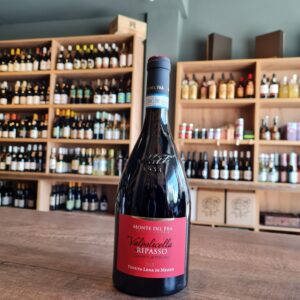 The Monte del Fra Valpolicella Classico appears deep ruby red with ripe red fruit accompanied with spice and earthiness on the nose. The palate displays delicious cherry and plum fruit, locked with sweet liquorice and warm cinnamon, finishing full, with velvety soft tannins and spice. Excellent wine that will get better and better, allow to breathe, even decant and would be best served with roasts, stews, braised meats and strong cheese.
The Monte del Fra Valpolicella Classico appears deep ruby red with ripe red fruit accompanied with spice and earthiness on the nose. The palate displays delicious cherry and plum fruit, locked with sweet liquorice and warm cinnamon, finishing full, with velvety soft tannins and spice. Excellent wine that will get better and better, allow to breathe, even decant and would be best served with roasts, stews, braised meats and strong cheese. -
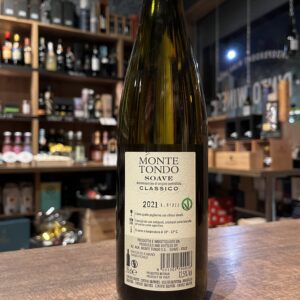
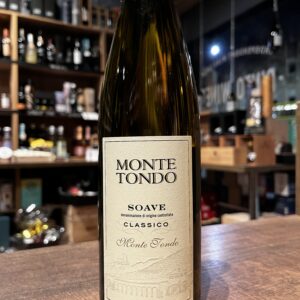
Monte Tondo is a family estate located in the beautiful hillside vineyards of Soave. Here the soils range from volcanic to chalky, which alongside the varying microclimates, gives the wines distinct flavour characteristics and individualistic style.
Alongside his family, winemaker Gino Magnabosco is part of the third generation to run the estate. They believe that hard work, drive, and determination are key to obtaining the best results from their land. Maintaining, nourishing, and cherishing the land of their ancestors is of utmost importance. And although not certified, they farm using organic practices and an environmentally friendly approach to both viticulture and vinification. No chemicals are used in their production and they recycle everything excess coming from the vineyard (stems as fertilizers, skins for grappa, pruned branches for heating and fertilizer).
Small proportions of other varieties are allowed in the production of Soave, but Monte Tondo focus their concentration purely on Garganega. Garganega is a variety so versatile and easily culinary matched but also with the ability to produce complex wines with age-ability.
A very good example of Soave at a very good price. This over-delivers.. Perfect with salads and light fish and shellfish dishes.
-
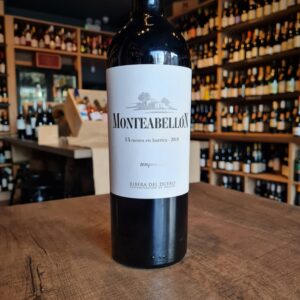 This Monteabellón 14 months is a wine made 100% with Tempranillo grapes from the highest altitude vineyards, located on sandy loam soils with clay and limestone. After a classic vinification, with 25 days of maceration, it is aged for 14 months in barrels of 70% French oak and 30% American . At Bodegas Monteabellón they use the latest oenological techniques to guarantee careful preparation throughout the process, maintaining stable levels of temperature and humidity. Smells of dark, ripe and very rich fruits. Unbelievably full-bodied and the finish is lasting and very long. This 100% Tempranillo is a complex wine that is already very enjoyable to drink, but will continue to develop splendidly over the next few years. Elegant and chocolate all over this wine. A shout to Declan & Mairead as they recommended this lovely addition to Pinto Wines!
This Monteabellón 14 months is a wine made 100% with Tempranillo grapes from the highest altitude vineyards, located on sandy loam soils with clay and limestone. After a classic vinification, with 25 days of maceration, it is aged for 14 months in barrels of 70% French oak and 30% American . At Bodegas Monteabellón they use the latest oenological techniques to guarantee careful preparation throughout the process, maintaining stable levels of temperature and humidity. Smells of dark, ripe and very rich fruits. Unbelievably full-bodied and the finish is lasting and very long. This 100% Tempranillo is a complex wine that is already very enjoyable to drink, but will continue to develop splendidly over the next few years. Elegant and chocolate all over this wine. A shout to Declan & Mairead as they recommended this lovely addition to Pinto Wines! -
Out of stock
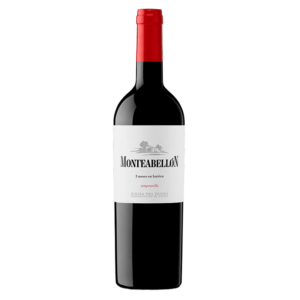 This attractive wine has its origin in the coolest vineyards located near the Douro River. The soil is sandy-loam with a slight gravel content. This gives it a very characteristic freshness that, combined with its aging in the barrel for 5 months (50% French and 50% American), gives rise to a wine with great personality and marked fruity nuances. Intense, bright cherry color. Very intense aroma with marked fruity sensations of blackberry and blueberries perfectly integrated with a quality wood that surrounds everything. Good structure and good fruity expression on the palate, powerful and with ripe tannins. An Oak from Ribera del Duero that you cannot miss.
This attractive wine has its origin in the coolest vineyards located near the Douro River. The soil is sandy-loam with a slight gravel content. This gives it a very characteristic freshness that, combined with its aging in the barrel for 5 months (50% French and 50% American), gives rise to a wine with great personality and marked fruity nuances. Intense, bright cherry color. Very intense aroma with marked fruity sensations of blackberry and blueberries perfectly integrated with a quality wood that surrounds everything. Good structure and good fruity expression on the palate, powerful and with ripe tannins. An Oak from Ribera del Duero that you cannot miss. -
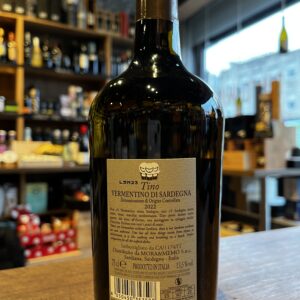
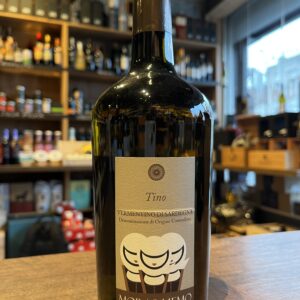 Their Vineyard is located in the south eastern corner of Sardinia in a rolling hill area looking at the sea of the Gulf of Cagliari. Vines with an average age of forty years our vineyards are able to express the best from the terroir of the south Sardinia. A unique terroir with the Sette Fratelli mountains, the tallest ones of the south of the island, just a mile away from the winery, behind them the beatiful beaches overlooking the Thyreenian sea. Pair with seafood in general, fish and delicate meat served with light sauces, soups or pasta.
Their Vineyard is located in the south eastern corner of Sardinia in a rolling hill area looking at the sea of the Gulf of Cagliari. Vines with an average age of forty years our vineyards are able to express the best from the terroir of the south Sardinia. A unique terroir with the Sette Fratelli mountains, the tallest ones of the south of the island, just a mile away from the winery, behind them the beatiful beaches overlooking the Thyreenian sea. Pair with seafood in general, fish and delicate meat served with light sauces, soups or pasta. -
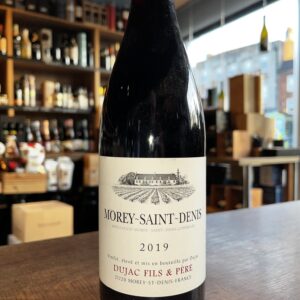 Founded in 1967 by Jacques Seysses, who transforms a newly acquired property into the Dujac domaine, it is now run together with his sons Jeremy, winemaker, and Alec. The property has 17.30 hectares of which a small part cultivated with chardonnay for an average production of less than 80,000 bottles. Jacques and his son Jeremy (whose wife Diana winemaker works in the domaine) are faithful to a very marked pinot noir through the vinification of whole grapes: the wine obtained rarely has a great color, but after a long aging (even beyond the thirty ' years) tertiary aromas do justice to this winemaking. Dujac style is the search for elegance and finesse with integrated and soft tannins always with balance, harmony, length and complexity. At the base the work in the vineyard, serious and rigorous, where the experience and knowledge of technology can help in the small imperfections of the vintage, but without any tampering. The brothers Alec and Jeremy, continuing in their father's work, are today considered among the best interpreters of the Pinot Noir of the Côte de Nuits and the Domaine Dujac can be fully confirmed as one of the most important Burgundy producers. In 2019 Morey has had another very successful vintage, receiving more rainfall in August than anywhere else on the Côte. The limestone subsoil also seems to give the wines a little more bite. The fruit is perfumed, with the classic Morey blueberry touches. The wine has good concentration and an energetic finish.
Founded in 1967 by Jacques Seysses, who transforms a newly acquired property into the Dujac domaine, it is now run together with his sons Jeremy, winemaker, and Alec. The property has 17.30 hectares of which a small part cultivated with chardonnay for an average production of less than 80,000 bottles. Jacques and his son Jeremy (whose wife Diana winemaker works in the domaine) are faithful to a very marked pinot noir through the vinification of whole grapes: the wine obtained rarely has a great color, but after a long aging (even beyond the thirty ' years) tertiary aromas do justice to this winemaking. Dujac style is the search for elegance and finesse with integrated and soft tannins always with balance, harmony, length and complexity. At the base the work in the vineyard, serious and rigorous, where the experience and knowledge of technology can help in the small imperfections of the vintage, but without any tampering. The brothers Alec and Jeremy, continuing in their father's work, are today considered among the best interpreters of the Pinot Noir of the Côte de Nuits and the Domaine Dujac can be fully confirmed as one of the most important Burgundy producers. In 2019 Morey has had another very successful vintage, receiving more rainfall in August than anywhere else on the Côte. The limestone subsoil also seems to give the wines a little more bite. The fruit is perfumed, with the classic Morey blueberry touches. The wine has good concentration and an energetic finish. -
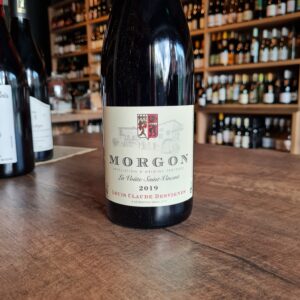 Louis-Claude Desvignes is a family estate that dates back to 1700. The Desvignes range is "La Voûte Saint Vincent", named for the vault or "voûte" of the old family house and for the patron saint of winemakers. It was Louis-Claude who began to turn the estate’s grapes into wine, and now with the reins handed over to his two sons Louis-Benoît and Claude-Emmanuelle Desvignes. It is a blend of certified-organic estate parcels totalling 4.5 hectares in the climat of Douby, which lies in the northeast corner of Morgon along the border of Fleurie. The La Voûte vines average 50 years old and are planted in Douby's typical sandy, decomposed-granite soils. Viticulture and vinification are consistent across all Desvignes wines. In the case of La Voûte, the parcels are all vinified separately.
Louis-Claude Desvignes is a family estate that dates back to 1700. The Desvignes range is "La Voûte Saint Vincent", named for the vault or "voûte" of the old family house and for the patron saint of winemakers. It was Louis-Claude who began to turn the estate’s grapes into wine, and now with the reins handed over to his two sons Louis-Benoît and Claude-Emmanuelle Desvignes. It is a blend of certified-organic estate parcels totalling 4.5 hectares in the climat of Douby, which lies in the northeast corner of Morgon along the border of Fleurie. The La Voûte vines average 50 years old and are planted in Douby's typical sandy, decomposed-granite soils. Viticulture and vinification are consistent across all Desvignes wines. In the case of La Voûte, the parcels are all vinified separately. -
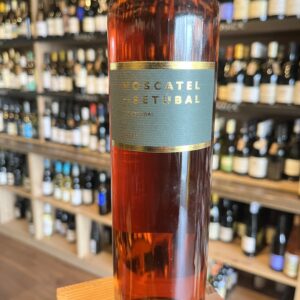
Casa Ermelinda Freitas
The warmth of the Portuguese sun is tempered at Casa Ermelinda thanks to the breezes blowing in from the Atlantic that lies close by. Located at Palmela on the peninsula of Setubal, close to the Sado estuary south of Lisbon, there are currently 440 hectares of many different kinds of vines across the domain, with grapes supplied locally from a further 500ha or so. Head of the company Leonor Freitas has worked tirelessly to make many improvements out in the vineyards and in the winery where modern equipment goes hand in hand with traditional values under the skilled guidance of winemaker Jaime Quendera. Casa Ermelinda Freitas has been run by a long line of dynamic women, celebrating its 100 year anniversary in 2020.
-
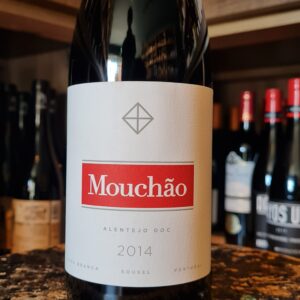 Herdade do Mouchao is a historic winery in Portugal’s Alentejo region that specialises in producing excellent red wines from the local Alicante Bouschet grape. The estate’s roots date back to the 19th century when Thomas Reynolds first moved from Porto to Alentejo to enter the prosperous cork-making industry. Later his grandson, John Reynolds saw an opportunity to start making both wine and corks and purchased the 900 hectare Herdade do Mouchao estate. Vineyards were planted, in 1901 he built a high-ceilinged adobe winery (or “adega”) and a distillery was added to the winery in 1929, where until today Mouchão's pommace brandy is produced. Unfortunately the estate was seized in 1974 by order of the powerful military government ruling the country at the time. The Reynolds were only able to regain the estate in 1985 and today the family works around 38 hectares of vines. Today, the Herdade do Mouchão continues to be run by the descendants of the original family whose cellar and vineyard workers have been with them for generations. The process is, as it always has been, unhurried (There is alway Manana). The grape varieties are local, picked by hand and foot-trodden. In the ever-changing world of winemaking, Herdade do Mouchão, remains a traditional, family-run winery.
Herdade do Mouchao is a historic winery in Portugal’s Alentejo region that specialises in producing excellent red wines from the local Alicante Bouschet grape. The estate’s roots date back to the 19th century when Thomas Reynolds first moved from Porto to Alentejo to enter the prosperous cork-making industry. Later his grandson, John Reynolds saw an opportunity to start making both wine and corks and purchased the 900 hectare Herdade do Mouchao estate. Vineyards were planted, in 1901 he built a high-ceilinged adobe winery (or “adega”) and a distillery was added to the winery in 1929, where until today Mouchão's pommace brandy is produced. Unfortunately the estate was seized in 1974 by order of the powerful military government ruling the country at the time. The Reynolds were only able to regain the estate in 1985 and today the family works around 38 hectares of vines. Today, the Herdade do Mouchão continues to be run by the descendants of the original family whose cellar and vineyard workers have been with them for generations. The process is, as it always has been, unhurried (There is alway Manana). The grape varieties are local, picked by hand and foot-trodden. In the ever-changing world of winemaking, Herdade do Mouchão, remains a traditional, family-run winery. -
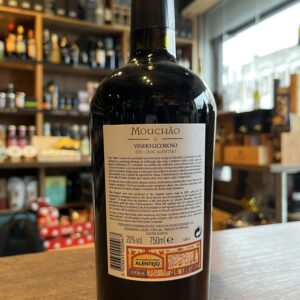
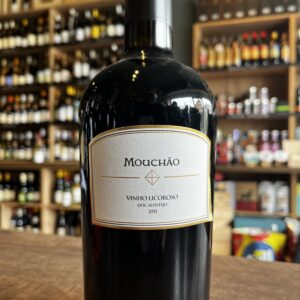 This fortified wine has been produced in Mouchão since the winery was built in 1901. The best grapes from Alicante Bouschet were harvested by hand and trodden by foot in traditional stone presses. The grapes are gently macerated until the fermentation process begins in order to develop a round, subtle and soft mouthfeel. After 120 years, this fortified dessert wine continues to be essential in the homes of Alentejo families at Christmas time. Sold and consumed young, mainly at the beginning of December of the same year of production. Nowadays its popularity is growing outside the festive season and is served in restaurants, very cold after meals. A very traditional and forming part of the tradition of the Northeast Alentejo.
This fortified wine has been produced in Mouchão since the winery was built in 1901. The best grapes from Alicante Bouschet were harvested by hand and trodden by foot in traditional stone presses. The grapes are gently macerated until the fermentation process begins in order to develop a round, subtle and soft mouthfeel. After 120 years, this fortified dessert wine continues to be essential in the homes of Alentejo families at Christmas time. Sold and consumed young, mainly at the beginning of December of the same year of production. Nowadays its popularity is growing outside the festive season and is served in restaurants, very cold after meals. A very traditional and forming part of the tradition of the Northeast Alentejo. -
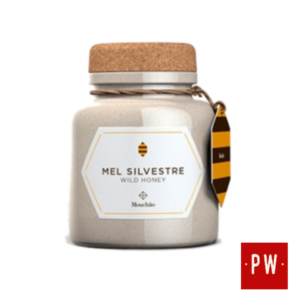 Although beehives have existed in Mouchão for over a century, honey was first commercially sold in 2011. In the expansive and natural surroundings of the estate, bees craft this wild honey with pollen from native shrubs, trees, and wild meadows. Beekeeping intervention is limited almost exclusively to harvesting. The honey, due to its purity, tends to thicken over time and can vary both in consistency and in its darker golden hue. Usually with a thick but smooth texture, it has floral highlights of orange blossom, wild lavender, and jasmine, with undertones of biscuit, butter, and dried fruits. As this is a raw honey, over the months it tends to thicken and can vary both in consistency and in darker golden hues.
Although beehives have existed in Mouchão for over a century, honey was first commercially sold in 2011. In the expansive and natural surroundings of the estate, bees craft this wild honey with pollen from native shrubs, trees, and wild meadows. Beekeeping intervention is limited almost exclusively to harvesting. The honey, due to its purity, tends to thicken over time and can vary both in consistency and in its darker golden hue. Usually with a thick but smooth texture, it has floral highlights of orange blossom, wild lavender, and jasmine, with undertones of biscuit, butter, and dried fruits. As this is a raw honey, over the months it tends to thicken and can vary both in consistency and in darker golden hues. -
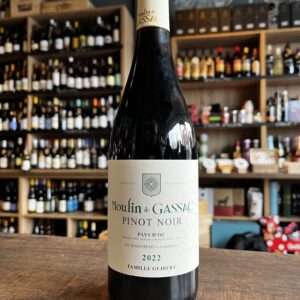 One of the wine films that has had the greatest impact on the industry is undoubtedly Jonathan Nossiter's “Mondovino”. This film was presented at the Cannes Film Festival in 2004, and essentially reflects the conflict between those who understand wine production as a basic artisan work that is completely connected to the land, and those who see it as a corporate business. One of the interviewees featured in the documentary is Aimé Guibert. Creator and champion of the renowned Mas Daumas Gassac, it is thanks to his obsession of giving absolute prominence to the vineyard that he manages to extol the quality of the wines of Languedoc, a region historically known for producing low quality table wines. So when Robert Mondavi, a wine magnate, became interested in this still under used region, Aimé fought with all his might until Mondavi withdrew from his venture. Now, it is his children who continue to protect this legacy with the same passion. A legacy based not so much on the category of the wine as on its quality. Although these wines only carry the vin de pays de l'Oc label, they are considered by great wine specialists to be the “Lafite Rothschilds” of Languedoc-Roussillon.
One of the wine films that has had the greatest impact on the industry is undoubtedly Jonathan Nossiter's “Mondovino”. This film was presented at the Cannes Film Festival in 2004, and essentially reflects the conflict between those who understand wine production as a basic artisan work that is completely connected to the land, and those who see it as a corporate business. One of the interviewees featured in the documentary is Aimé Guibert. Creator and champion of the renowned Mas Daumas Gassac, it is thanks to his obsession of giving absolute prominence to the vineyard that he manages to extol the quality of the wines of Languedoc, a region historically known for producing low quality table wines. So when Robert Mondavi, a wine magnate, became interested in this still under used region, Aimé fought with all his might until Mondavi withdrew from his venture. Now, it is his children who continue to protect this legacy with the same passion. A legacy based not so much on the category of the wine as on its quality. Although these wines only carry the vin de pays de l'Oc label, they are considered by great wine specialists to be the “Lafite Rothschilds” of Languedoc-Roussillon.


